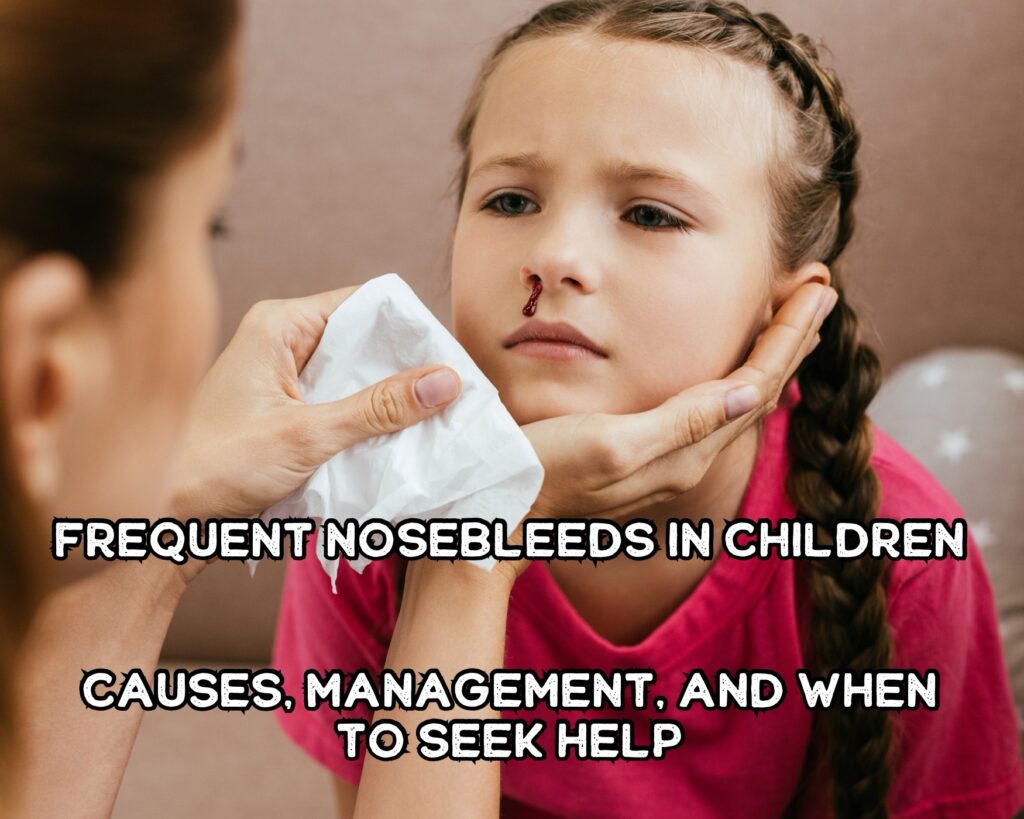As a child, I remember the panic and discomfort that came with frequent nosebleeds. It seemed like a never-ending cycle, with each episode bringing a sense of dread. The culmination of these events led to a procedure known as nasal cauterization—an attempt to put an end to what felt like countless interruptions to school and play. Fast forward to the present, and history seems to be repeating itself with my own child. The sight of blood, the rush for tissues, and the calming reassurances are all too familiar. This personal experience with frequent nosebleeds, both as a child and now as a parent, has propelled me to explore deeper into the causes, management, and when to seek medical advice for this common yet distressing issue.

Nosebleeds, or epistaxis, are a prevalent concern among children, often causing more alarm for parents and caregivers than harm to the child. My journey through managing my child’s frequent nosebleeds has been a path of learning, understanding, and sometimes, frustration. It’s a condition that many children face, yet the conversation around it seems minimal.
In this article, I’ll share insights gained from personal experiences combined with research and medical advice. From the common causes that trigger these episodes to effective strategies for management and prevention, this narrative aims to provide a comprehensive guide for parents navigating the same challenges. Whether your child experiences occasional nosebleeds or, like mine, faces them regularly, understanding the nuances of this condition is the first step toward managing it with confidence and care.

First Aid and Home Management Strategies
Dealing with frequent nosebleeds in children can be daunting, but over the years, both from my childhood experiences and now as a parent, I’ve learned that effective management is key to reducing both the frequency and severity of these episodes. One of the simplest yet most effective techniques I’ve discovered involves using a small piece of tissue. Here’s a step-by-step guide that has worked wonders for us, especially when my son is dealing with a nosebleed.
- Stay Calm: First and foremost, it’s important to stay calm. Children often look to adults for reassurance, especially in situations that involve blood.
- Sit Up and Lean Forward: Encourage your child to sit up straight and lean slightly forward. This position prevents the blood from flowing down the throat, which can cause coughing or gagging.
- Roll a Small Piece of Tissue: Take a small piece of tissue and roll it up into a thin strip. It doesn’t need to be too thick; just enough to fit comfortably into the nostril.
- Insert the Tissue into the Nostril: Gently insert the rolled-up tissue into the nostril that’s bleeding. This acts as a barrier, absorbing the blood and aiding in clot formation. Ensure it’s not inserted too far; it should be comfortable for your child.
- Wait and Remove: After a few minutes, once the bleeding has subsided, carefully remove the tissue. If the bleeding continues, replace it with a fresh piece.
This method has been a game-changer for us. It allows my son to move around without the need to constantly hold a tissue to his nose, giving him a bit of freedom even when a nosebleed strikes. For those looking for a more ready-made solution, especially useful for travel or when out and about, consider products like Nampons for Nosebleeds – 6 Nasal Plugs with Clotting Agent to Stop Nosebleeds Fast. Trusted by doctors, nurses, and first responders, these nasal plugs are safe and effective for children, adults, and seniors. They work on the same principle as the tissue method but are specifically designed to stop nosebleeds quickly and are incredibly convenient to have on hand.
Managing nosebleeds at home requires patience and a few simple strategies. While the tissue method has been beneficial for us, having a product like Nampons on hand offers peace of mind knowing we’re prepared to handle nosebleeds efficiently, wherever we are. Whether you’re at home or on the go, these tips and tools can help minimize the disruption caused by nosebleeds and ensure your child is comfortable and safe.

Rethinking the Old Advice: Why Not to Lean Back During a Nosebleed
For many years, the common advice for handling nosebleeds was to tilt the head back. This method, once widely recommended, is now known to be less effective and potentially problematic. Understanding why this shift in guidance has occurred can help ensure we’re providing the best care for our children during these unsettling moments.
The Shift from Back to Forward:
Leaning back during a nosebleed can actually cause the blood to flow down the back of the throat. While this might reduce the visible bleeding from the nose, it doesn’t stop the bleeding itself. More concerning is the risk of swallowing blood, which can irritate the stomach and lead to nausea or vomiting. Additionally, blood trickling down the throat poses a risk of choking, especially in children or in situations where the individual cannot express discomfort or distress.
Leaning Forward: The Recommended Method:
The current recommendation is to lean slightly forward while pinching the soft part of the nose. This position helps in several ways:
- It allows the blood to drain out through the nostril, which is safer and prevents swallowing.
- Pinching the nose helps to apply direct pressure to the site of the bleed, aiding in clot formation and stopping the bleed more effectively.
- Keeping the head above the heart reduces the pressure in the nasal blood vessels, potentially slowing the bleeding.
Implementing the Forward Lean Method:
- Stay Calm: Keep your child calm and reassure them as you guide them to lean forward.
- Pinch the Nose: Use your thumb and index finger to gently pinch the soft part of the nose, just above the nostrils. Hold this pressure without releasing for about 10 minutes.
- Breathe Through the Mouth: Encourage your child to breathe through their mouth while you’re applying pressure to their nose.
- Check and Release: After 10 minutes, release the pressure gently to see if the bleeding has stopped. If it hasn’t, continue to apply pressure for another 10 minutes.
For those looking for additional support during nosebleeds or when on the go, products designed to manage nosebleeds can be invaluable. Nampons for Nosebleeds are a convenient option, offering a safe and effective way to control bleeding. These nasal plugs, which come with a clotting agent, can be a practical addition to your first-aid kit, especially for children prone to frequent nosebleeds. They’re designed to be used in conjunction with the forward-leaning method, ensuring the bleeding is managed safely until it stops.
The evolution from leaning back to leaning forward during a nosebleed reflects our improved understanding of how to manage these common occurrences more safely and effectively. By adopting this method, we can minimize complications and discomfort for our children, providing them with the best care possible during those unexpected moments.

When to See a Doctor
Navigating the waters of childhood nosebleeds involves not only knowing how to manage them at home but also understanding when it’s time to seek professional medical advice. Despite the best home management efforts, there are certain signs and symptoms that indicate a need for a doctor’s evaluation.
Persistent Bleeding: If a nosebleed doesn’t stop after 20 minutes of continuous pressure or if it recurs frequently over a short period, it’s time to consult a doctor. Persistent bleeding could be a sign of a more significant underlying issue that needs medical attention.
Signs of Anemia: Frequent nosebleeds can sometimes lead to anemia, especially if they’re heavy or occur over an extended period. Symptoms like fatigue, paleness, or shortness of breath should prompt a visit to the doctor.
Unusual Symptoms: If a nosebleed is accompanied by unusual symptoms such as fever, rash, or bruising, it could indicate a more serious condition that requires immediate medical attention.
Impact on Daily Life: When nosebleeds become so frequent that they interfere with a child’s daily activities, sleep, or school, it’s advisable to seek medical advice. A healthcare professional can offer treatments or interventions that may reduce the frequency or severity of the nosebleeds.
During the doctor’s visit, you can expect a thorough examination, which may include checking the child’s nose, asking about family medical history, and possibly running some blood tests to rule out any blood disorders. The doctor might also inquire about any recent injuries or trauma to the nose that could be contributing to the problem.
For those who have found products like Nampons for Nosebleeds useful in managing nosebleeds at home, sharing this information with your doctor can be helpful. It provides them with a complete picture of what measures have been effective and which ones haven’t, aiding in their assessment and recommendations for further treatment or management strategies.
Remember, while home management techniques and products can significantly aid in controlling nosebleeds, they do not replace professional medical advice, especially in cases where there are concerns about the frequency, duration, or associated symptoms of the nosebleeds. Always err on the side of caution and consult a healthcare provider when in doubt, ensuring your child receives the best possible care.
Preventive Measures and Lifestyle Adjustments
Dealing with my child’s frequent nosebleeds has been a journey filled with trial and error, leading me to discover effective strategies that not only manage but also help prevent these episodes. Reflecting on my own experiences as a child and the solutions we’ve implemented, I’ve learned the importance of creating an environment and adopting habits that minimize the triggers of nosebleeds. Here’s how we’ve made impactful changes.
Humidifying the Home Environment: Dry indoor air, particularly during winter months with the heating on, has been a significant trigger for nosebleeds in our household. Investing in a humidifier was a game-changer. We chose the Dreo 4L Smart Humidifiers for Bedroom, which features a quiet operation, a large capacity for a long runtime, and even a diffuser and nightlight. Its ability to maintain a consistent level of humidity in my child’s bedroom and throughout our home has notably decreased the frequency of nosebleeds.
Allergy Management: Allergies are another common culprit behind my child’s nosebleeds. By implementing a comprehensive allergy management plan, including regular cleaning to reduce dust mites and using hypoallergenic bedding, we’ve seen a marked improvement. On the advice of an allergist, staying proactive with allergy medications has also been key in keeping those allergy-induced nosebleeds at bay.
Encouraging Gentle Nose Blowing and Proper Nasal Hygiene: Educating my child on the importance of gentle nose blowing has made a significant difference. We’ve practiced the technique of blowing one nostril at a time gently and using soft, moist tissues to avoid irritating the nasal passages. This approach, coupled with regular use of saline nasal sprays to keep the nasal lining moist, has helped reduce the occurrence of nosebleeds significantly.
Incorporating these preventive measures and adjustments into our daily routine has not only lessened the frequency of my child’s nosebleeds but also eased the anxiety that comes with them. For parents navigating similar challenges, understanding and managing your child’s nosebleeds involves a combination of immediate care strategies and long-term preventive measures. For further insights and tips on managing frequent nosebleeds in children, exploring resources like Understanding and Managing Your Child’s Frequent Bloody Noses can provide valuable information and support. Adopting these practices has empowered us to handle nosebleeds more effectively, ensuring my child can play, sleep, and learn without the constant interruption of nosebleeds.

Empowering Parents and Caregivers
Navigating the journey of frequent childhood nosebleeds, from my personal battles as a child to managing my son’s episodes, has been an enlightening path filled with learning, adapting, and overcoming. Through a blend of firsthand experience and diligent research, we’ve developed strategies that significantly reduce the frequency and severity of these incidents, offering a sense of control and reassurance to both my child and me. As we wrap up this discussion, I’d like to address some common questions and concerns that many parents and caregivers might have about this topic.
How common are frequent nosebleeds in children, and at what age do they usually begin?
Frequent nosebleeds are quite common in children, especially between the ages of 2 and 10. This prevalence is due to the delicate nature of their nasal membranes, which are easily irritated.
Can frequent nosebleeds be a sign of a more serious health issue?
While most nosebleeds in children are not a cause for alarm, they can sometimes indicate underlying health issues, such as blood clotting disorders or high blood pressure. If nosebleeds are frequent, severe, or accompanied by other symptoms, consulting a healthcare provider is crucial.
Are there any dietary changes that can help prevent nosebleeds?
Keeping your child well-hydrated can help maintain the moisture in the nasal passages. Some evidence suggests that foods high in vitamin C and K, which aid in blood clotting and vessel health, might be beneficial. However, dietary changes should complement other preventive measures rather than replace them.
How can I prepare my child for dealing with nosebleeds at school or away from home?
Educating your child on how to manage a nosebleed safely and confidently is key. Teach them to lean forward, pinch their nose, and breathe through their mouth. Packing a small kit with tissues, saline spray, and instructions can also empower them to handle nosebleeds independently.
Will my child outgrow frequent nosebleeds?
Many children do outgrow frequent nosebleeds as they get older and their nasal tissues become less sensitive. However, continuing to practice good nasal hygiene and preventive measures can help minimize occurrences as they age.
In closing, understanding and managing frequent nosebleeds in children requires patience, knowledge, and proactive measures. While the journey may seem daunting at times, remember that you are not alone. Resources, communities, and healthcare professionals are available to support you. By implementing the strategies discussed and seeking medical advice when necessary, you can provide your child with the care and comfort they need, ensuring nosebleeds become a manageable part of their childhood rather than a defining aspect.
For parents seeking more in-depth information and resources on this topic, Understanding and Managing Your Child’s Frequent Bloody Noses offers a comprehensive guide that can further aid in your journey towards effective management and prevention. Remember, the goal is not just to treat nosebleeds as they occur, but to empower our children with the knowledge and tools they need to lead happy, healthy lives.
As an Amazon Associate we earn from qualifying purchases through some links in our articles.




